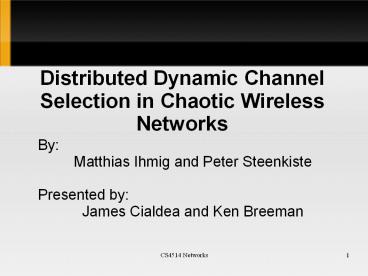Distributed Dynamic Channel Selection in Chaotic Wireless Networks PowerPoint PPT Presentation
Title: Distributed Dynamic Channel Selection in Chaotic Wireless Networks
1
Distributed Dynamic Channel Selection in Chaotic
Wireless Networks
- By
- Matthias Ihmig and Peter Steenkiste
- Presented by
- James Cialdea and Ken Breeman
2
Overview
- Wireless networking problem Channel
Allocation - A proposed solution Dynamic Channel Selection
- Proposed algorithm explained.
- Simulations using OPNET
- Conclusions
3
Problem
- Wireless networking is popular
- Many users in contention for a finite amount of
bandwidth per channel - Most users do not properly configure their
devices to maximize throughput - Even if they do, the situation can change at any
time - Wireless Channel Selection Issues Include
- High density of APs
- Unpredictable, Dynamic load
4
Solution
- Dynamically select channel based on current load
conditions - Problems
- What devices should calculate load in an
unmanaged space? - How should load be calculated?
- How often should load be calculated?
- What is the best way to switch channels on the
fly?
5
Algorithm Overview
- Monitoring Component
- Monitor load on current channel
- Evaluation Component
- Compare current channel load against a threshold
- Trigger switch if this channel is no good
- Change threshold accordingly
- Channel Switching Component
- Set up the hardware for new channel
6
Algorithm
7
Channel Switching Coordination
- No Coordination
- The AP simply switches channels, expecting the
client to loose connectivity and reconnect - AP-Client Coordination
- The AP tells the client what channel to switch to
and when (SWITCH message)? - This is supported by 802.11k
- AP-AP Coordination
- The AP tells other APs what channel it plans to
switch to to avoid congestion (HOLD message)?
8
Where To Calculate Network Load
- Because this is an unmanaged, decentralized
system - Devices are not distributed across the space
evenly - No one device can be guaranteed to hear all other
devices - No one device can be trusted to calculate fairly
for all devices - All devices must calculate load for their
particular space and situation
9
Which metric?
10
Calculating Network Load
- Dynamic nature of traffic
- Dynamic number of clients
- Dynamic bandwidth demand
- Channel Utilization
- Many spikes can cause false triggers
- Transmit Queue Length
- Easy to measure
- Highly variable many false triggers
- MAC/Packet Delay
- Transmit queue and channel contention time
measured - Most attractive very steady readings
11
OPNET Simulation
- Utilizes both SWITCH for AP-Client coordination
and HOLD for AP-AP coordination - Comparison
- All APs and clients on a single channel
- All APs and clients on non-overlapping channels
- APs set to dynamically configure channel and
coordinate with clients and other APs
12
Simulation Result
- Single channel performance was poor as expected
- Manually configured on non-overlapping channels
provided the most throughput as expected - Dynamic configuration provided about 5 less
throughput than the manually configured
non-overlapping channel setup
13
Simulation Result
14
Tuning the Algorithm Coordination
- Removing Client-AP coordination for legacy
clients reduces performance around the channel
switch by a constant factor based on
rescan/reconnect time - Remove the SWITCH capability
- About 7 delay was gained and 2 throughput was
lost - Removing AP-AP coordination the HOLD capability
reduces the global throughput by about 3
15
Tuning the Algorithm Parameters
- Load Average
- The load is calculated using a moving average to
negate small changes - Shrinking the averaging interval
- Causes the system to converge on the maximum
global throughput quickly - Causes excessive channel switching
- Increasing the averaging interval
- Slower convergence
- Less time wasted switching channels
- Same is true of the channel hold time t_HOLD
16
Tuning the Algorithm Parameters (contin)?
- thres_min
- The threshold for channel switching
- Set to about 50 of channel capacity
- Higher values increase convergence time
- Lower causes increased number of channel switches
17
Tuning the Algorithm Parameters (contin)?
18
Conclusions
- A decentralized algorithm that works.
- Delay based metrics are suitable.
- 95 throughput compared to manual config.
- Handles varying usage.
19
Works Cited
- Article
- Distributed Dynamic Channel Selection in Chaotic
Wireless Networks - by Matthias Ihmig and Peter Steenkiste
20
Questions?

